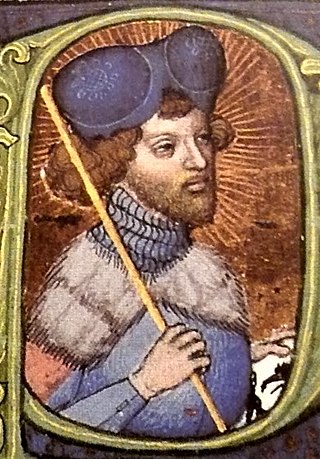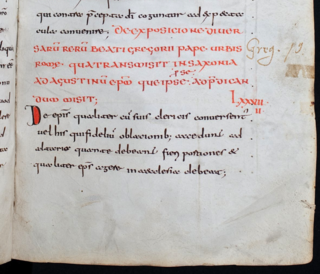Related Research Articles

Jan Hus, sometimes anglicized as John Hus or John Huss, and referred to in historical texts as Iohannes Hus or Johannes Huss, was a Czech theologian and philosopher who became a Church reformer and the inspiration of Hussitism, a key predecessor to Protestantism, and a seminal figure in the Bohemian Reformation. Hus is considered to be the first Church reformer, even though some designate the theorist John Wycliffe. His teachings had a strong influence, most immediately in the approval of a reformed Bohemian religious denomination and, over a century later, on Martin Luther.

Pope Boniface VIII was the head of the Catholic Church and ruler of the Papal States from 24 December 1294 to his death, in 1303. The Caetani family was of baronial origin, with connections to the papacy. He succeeded Pope Celestine V, who had abdicated from the papal throne. Boniface spent his early career abroad in diplomatic roles.

Pope Boniface IX was head of the Catholic Church from 2 November 1389 to his death, in October 1404. He was the second Roman pope of the Western Schism. During this time the Avignon claimants, Clement VII and Benedict XIII, maintained the Roman Curia in Avignon, under the protection of the French monarchy. He is the last pope to date to take on the pontifical name "Boniface".
Matthew of Kraków was a German-Polish scholar and priest of the fourteenth century.

Wenceslaus IV, also known as Wenceslaus of Luxembourg, was King of Bohemia from 1378 until his death and King of Germany from 1376 until he was deposed in 1400. As he belonged to the House of Luxembourg, he was also Duke of Luxembourg from 1383 to 1388.
Pope Damasus II was the Bishop of Rome and ruler of the Papal States from 17 July 1048 to his death on 9 August that same year. He was the second of the German pontiffs nominated by Emperor Henry III. A native of Bavaria, he was the third German to become pope and had one of the shortest papal reigns.
Dietrich of Nieheim, medieval historian, was born at Nieheim, a small town subject to the see of Paderborn.

The Western Schism, also known as the Papal Schism, the Great Occidental Schism, or the Schism of 1378, was a split within the Catholic Church lasting from 1378 to 1417 in which bishops residing in Rome and Avignon both claimed to be the true pope, and were joined by a third line of Pisan claimants in 1409. The schism was driven by personalities and political allegiances, with the Avignon papacy being closely associated with the French monarchy.

Francesco Zabarella was an Italian cardinal and canonist.
Angelo II Acciaioli was an Italian Catholic cardinal.

The Archdiocese of Pisa is a Latin Church metropolitan see of the Catholic Church in Pisa, Italy. It was founded in the 4th century and elevated to the dignity of an archdiocese on 21 April 1092 by Pope Urban II. The seat of the bishop is the cathedral of the Assumption in the Piazza del Duomo.
Johannes von Gmunden was a German/Austrian astronomer, mathematician, humanist and early instrument maker.

Jean Lemoine, Jean Le Moine, Johannes Monachus was a French canon lawyer, Cardinal, bishop of Arras and papal legate. He served Boniface VIII as representative to Philip IV of France, and founded the Collège du Cardinal Lemoine, in Paris. He is the first canon lawyer to formulate the legal principle of the presumption of innocence.
The numbering of "Popes John" does not occur in strict numerical order. Although there have been twenty-one legitimate popes named John, the numbering has reached XXIII because of two clerical errors that were introduced in the Middle Ages: first, antipope John XVI was kept in the numbering sequence instead of being removed; then, the number XX was skipped because Pope John XXI counted John XIV twice.
Johannes de Galonifontibus was a Dominican friar active in the South Caucasus in March 1377. He was appointed by Gregory XI on 9 March 1377 as Bishop of Nakhchivan. He is often mistaken for Archbishop of Sultaniya, John III of Soltaniyeh who was also a bishop of Nakhchivan because of Anton Kern, who published John III's Libellus de Notitia Orbis and tentatively associated him with his namesake.

Branda da Castiglione was an early Italian humanist, a papal diplomat and a Roman Catholic cardinal.

The Libellus responsionum is a papal letter written in 601 by Pope Gregory I to Augustine of Canterbury in response to several of Augustine's questions regarding the nascent church in Anglo-Saxon England. The Libellus was reproduced in its entirety by Bede in his Historia ecclesiastica gentis Anglorum, whence it was transmitted widely in the Middle Ages, and where it is still most often encountered by students and historians today. Before it was ever transmitted in Bede's Historia, however, the Libellus circulated as part of several different early medieval canon law collections, often in the company of texts of a penitential nature.

The Council of Pisa was a controversial council held in 1409. It attempted to end the Western Schism by deposing Benedict XIII (Avignon) and Gregory XII (Rome) for schism and manifest heresy. The College of Cardinals, composed of members of both the Avignon Obedience and the Roman Obedience, who were recognized by each other and by the Council, then elected a third papal claimant, Alexander V, who lived only a few months. He was succeeded by John XXIII.

Johannes Hoffmann von Schweidnitz was a Roman Catholic theologian, Professor of Theology and Rector at both Prague and Leipzig Universities, and served as Bishop of Meissen from 1427 until his death.

Pierre de Thury was a French bishop and cardinal of the Avignon Obedience, who served as a royal secretary and Master of Requests, and then as papal Nuncio and Apostolic Legate on several occasions. He participated in two papal elections, those of 1394 and 1409, and was a prominent member of the Council of Pisa in 1409.
References
- 1 2 3 4 5 Casali, Chiara (2010-03-24), "John of Sulṭāniyya", Christian-Muslim Relations 600 - 1500, Brill, retrieved 2023-12-29
- ↑ Luttrell, Anthony (2011-01-25), "TIMUR'S DOMINICAN ENVOY", TIMUR'S DOMINICAN ENVOY, Gorgias Press, pp. 209–230, doi:10.31826/9781463233723-017, ISBN 978-1-4632-3372-3 , retrieved 2023-12-29
- 1 2 A. Kern, 'Der "Libellus de notitia orbis" Iohannes III (de Galonifontibus?) O.P. Erzbishofs von Sulthanyeh', Archivium Fratrum Praedicatorum 8 (1938) pp. 81-123
- 1 2 3 The Cambridge history of Iran William Bayne Fisher, Peter Jackson, Laurence Lockhart p.375
- ↑ "1409 Juli 26 - Nr. 1635 aus Band III - Johann, Erzbischof von Sultanieh, stellt zu Gunsten des in der Kronstädter Marienkirche befindlichen Altars der Heiligleichnamsbruderschaft einen Ablassbrief aus". Urkundenbuch zur Geschichte der Deutschen in Siebenbürgen Online. Retrieved 2023-12-29.
- ↑ Loenertz, R. (1937). La Société des Frères pérégrinants - Étude sur l'Orient domenicain [The Society of Pilgrimage Brothers from 1374 to 1475: Study on the Dominican East] (in French). Rome: Dominican Historical Institute. p. 171.